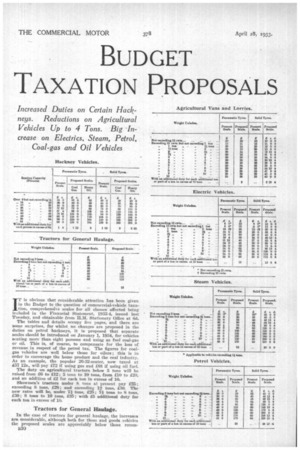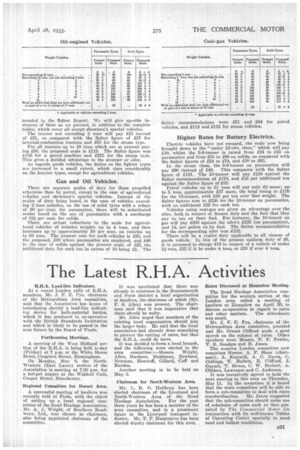BUDGET TAXATION PROPOSALS
Page 48

Page 49

If you've noticed an error in this article please click here to report it so we can fix it.
IT is obvious that considerable attention has been given in the Budget to the question of commercial-vehicle taxation, comprehensive scales for all classes affected being included in the Financial Statement, 1933-4, issued last Tuesday, and obtainable from H.M. Stationery Office at 6d.
The tables and details occupy five pages, and there are some surprises, for whilst, no changes are. proposed in the duties on petrol hackneys, it is proposed filet separate scales should be introduced on January 1, 1934, for vehicles stating more than eight persons and using as fuel coal-gas or oil. This is, of course, to compensate for the loss of revenue in respect of the petrol tax. The figures for coalgas vehicles are well below those for oilers ; this is in order to encourage the home product and the coal industry. As an example, the popular 26-32-seater, now taxed at £57 12s., will pay £72 if using gas and £88 if using oil fuel.
The duty on agricultural tractors below 5 tons will be raised from £6 to £12; 5 tons to 10 tons, from £10 to £20, and an addition of £2 for each ton in excess of 10.
Showmen's tractors under 8 tolls at present pay PZ; exceeding 8 tons, ilr; and exceeding 12 tons, £30. The new rates will be, under 71 tons. 25;. 7+ tons to 8 tons, £30; 8 tons to 10 tons, £35; with £5 additional duty for each ton in excess of 10.
Tractors for General Haulage.
In the ease of tractors for general haulage, the increases are considerable, although both for these and goods vehicles the proposed scales are appreciably below those recomB30 mended in the Salter Report. We will give specific instances of these as we proceed, in addition to the complete tables, which cover all except showmen's special vehicles.
The tractor not exceeding 2 tons will pay .125 instead of 121, as compared with the Salter figure of £27 for interual-combustion tractors and £53 for the steam type.
For all tractors up to 10 tons, which are at present paying 150, the proposed scale is .1115. The Salter figure was £155 for a petrol machine and £275 for the steam type. This gives a decided advantage to the steamer or oiler.
As regards goods vehicles, the duties on the lighter types Me increased to a small extent, which rises considerably on the heavier types, except for agricultural vehicles.
Gas and Oil Vehicles.
There are separate scales of duty for those propelled otherwise than by petrol, except in the case of agricultural vehicles and showmen's special vehicles. Instead of thu scales of duty being based, in the case of vehicles exceeding 2 tons unladen', on the use of solid tyres with a rebate of 20 per eent, for pneumatics, there will be substituted scales based on the use of pneumatics with a surcharge of $31 per cent. for solids.
There are actual reductions in the scale for agricultural vehicles of unladen weights up to 4 tons, and then increases up to approximately 50 per cent, on vehicles up to 10 tons. The present rate for such vehicles is 420, and the proposed, 130 where pneumatics are employed, and £40 in the ease of solids against the present scale of £25, the additional duty for each ton in excess of 10 being 12. The Salter recommendations Were £51 and £64 for petrol vehicles, and £119 and £1.32 for steam vehicles.
Higher Rates for Battery Electrics.
Electric vehicles have not escaped, the scale now being brought down to the "under 12-cwt. class," which will pay £10, whilst the 5-6-tonner is raised from 124 to £45 on pneumatics and from £20 to 160 on solids, as compared with tha Salter figures of 124 to 174, and £30 to £93.
In the steam class, the 5-6-tonner on pneumatics will pay 1.90 instead of £48. This compares with the Salter figure of £121. The 10-tonner will pay £150 against the Salter recommendation of £170, and 1.15 per additional ton against the Salter figure of £32.
Petrol vehicles up to 21 tons will pay only £2 more; up to 5 tons, approximately 427 more, the total rising to 1170 for the 10-tonner, with £24 per ton over that weight. The Salter figures rose to £226 for the 10-tonner on pneumatics, with an additional £32 for each ton. Vehicles using coal-gas are given an advantage over the oiler, both in respect of licence duty and the fact that they pay no tax on their fuel. For instance, the 10-tonner on gas will pay £205 against the oiler's £225 (on pneumatics), anti 1d. per gallon on its fuel. The Salter recommendation for the corresponding oiler was 1332.
There will be a trailer duty applicable to all classes of goods vehicle. In lieu of the present uniform duty of £6, it is proposed to charge 110 in respect of a vehicle of under 2/ tons, £15 if it be under 4 tons, or £20 if over 4 tons.




































































































